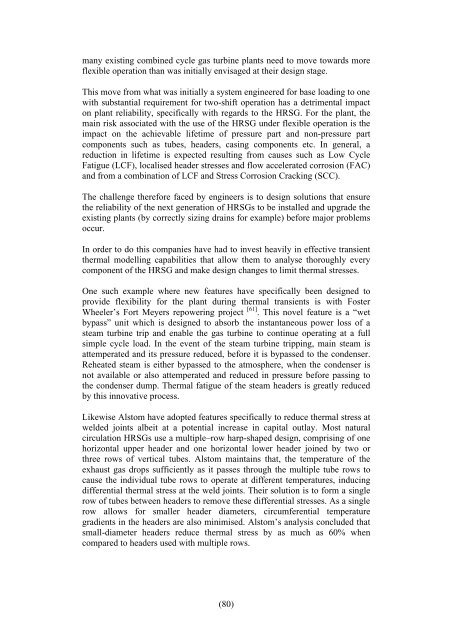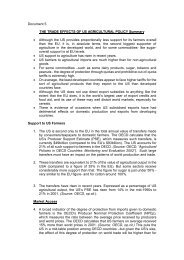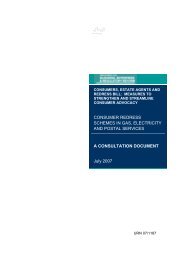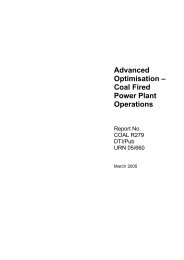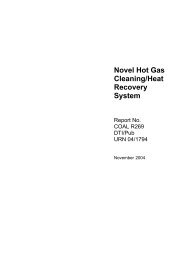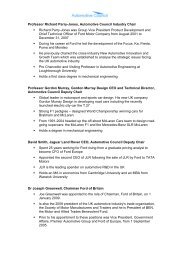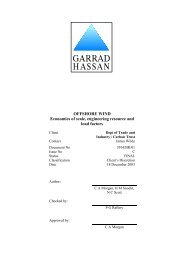(70) Therefore, the risk of sulphuric acid dew point attack ... - DTI Home
(70) Therefore, the risk of sulphuric acid dew point attack ... - DTI Home
(70) Therefore, the risk of sulphuric acid dew point attack ... - DTI Home
Create successful ePaper yourself
Turn your PDF publications into a flip-book with our unique Google optimized e-Paper software.
many existing combined cycle gas turbine plants need to move towards more<br />
flexible operation than was initially envisaged at <strong>the</strong>ir design stage.<br />
This move from what was initially a system engineered for base loading to one<br />
with substantial requirement for two-shift operation has a detrimental impact<br />
on plant reliability, specifically with regards to <strong>the</strong> HRSG. For <strong>the</strong> plant, <strong>the</strong><br />
main <strong>risk</strong> associated with <strong>the</strong> use <strong>of</strong> <strong>the</strong> HRSG under flexible operation is <strong>the</strong><br />
impact on <strong>the</strong> achievable lifetime <strong>of</strong> pressure part and non-pressure part<br />
components such as tubes, headers, casing components etc. In general, a<br />
reduction in lifetime is expected resulting from causes such as Low Cycle<br />
Fatigue (LCF), localised header stresses and flow accelerated corrosion (FAC)<br />
and from a combination <strong>of</strong> LCF and Stress Corrosion Cracking (SCC).<br />
The challenge <strong>the</strong>refore faced by engineers is to design solutions that ensure<br />
<strong>the</strong> reliability <strong>of</strong> <strong>the</strong> next generation <strong>of</strong> HRSGs to be installed and upgrade <strong>the</strong><br />
existing plants (by correctly sizing drains for example) before major problems<br />
occur.<br />
In order to do this companies have had to invest heavily in effective transient<br />
<strong>the</strong>rmal modelling capabilities that allow <strong>the</strong>m to analyse thoroughly every<br />
component <strong>of</strong> <strong>the</strong> HRSG and make design changes to limit <strong>the</strong>rmal stresses.<br />
One such example where new features have specifically been designed to<br />
provide flexibility for <strong>the</strong> plant during <strong>the</strong>rmal transients is with Foster<br />
Wheeler’s Fort Meyers repowering project [61] . This novel feature is a “wet<br />
bypass” unit which is designed to absorb <strong>the</strong> instantaneous power loss <strong>of</strong> a<br />
steam turbine trip and enable <strong>the</strong> gas turbine to continue operating at a full<br />
simple cycle load. In <strong>the</strong> event <strong>of</strong> <strong>the</strong> steam turbine tripping, main steam is<br />
attemperated and its pressure reduced, before it is bypassed to <strong>the</strong> condenser.<br />
Reheated steam is ei<strong>the</strong>r bypassed to <strong>the</strong> atmosphere, when <strong>the</strong> condenser is<br />
not available or also attemperated and reduced in pressure before passing to<br />
<strong>the</strong> condenser dump. Thermal fatigue <strong>of</strong> <strong>the</strong> steam headers is greatly reduced<br />
by this innovative process.<br />
Likewise Alstom have adopted features specifically to reduce <strong>the</strong>rmal stress at<br />
welded joints albeit at a potential increase in capital outlay. Most natural<br />
circulation HRSGs use a multiple–row harp-shaped design, comprising <strong>of</strong> one<br />
horizontal upper header and one horizontal lower header joined by two or<br />
three rows <strong>of</strong> vertical tubes. Alstom maintains that, <strong>the</strong> temperature <strong>of</strong> <strong>the</strong><br />
exhaust gas drops sufficiently as it passes through <strong>the</strong> multiple tube rows to<br />
cause <strong>the</strong> individual tube rows to operate at different temperatures, inducing<br />
differential <strong>the</strong>rmal stress at <strong>the</strong> weld joints. Their solution is to form a single<br />
row <strong>of</strong> tubes between headers to remove <strong>the</strong>se differential stresses. As a single<br />
row allows for smaller header diameters, circumferential temperature<br />
gradients in <strong>the</strong> headers are also minimised. Alstom’s analysis concluded that<br />
small-diameter headers reduce <strong>the</strong>rmal stress by as much as 60% when<br />
compared to headers used with multiple rows.<br />
(80)


